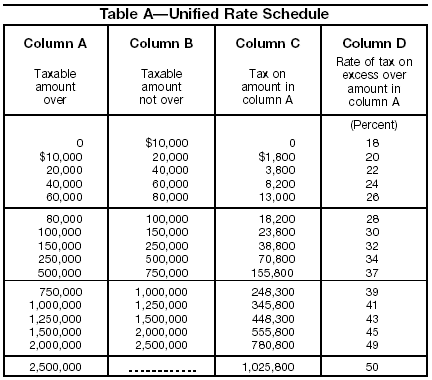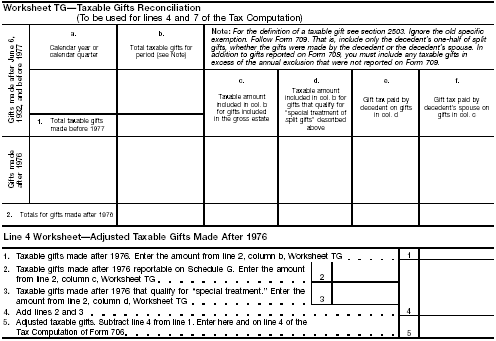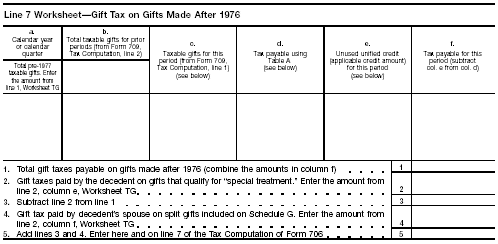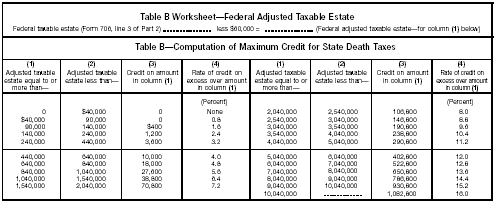H. Amending Form 706
If you find that you must change something on a return that has already been filed, you should file another Form 706 and write Supplemental
Information across the top of page 1 of the form. If you have already been notified that the return has been selected for examination, you should
provide the additional information directly to the office conducting the examination.
I. Supplemental Documents
You must attach the death certificate to the return.
If the decedent was a citizen or resident and died testate, attach a certified copy of the will to the return. If you cannot obtain a certified
copy, attach a copy of the will and an explanation of why it is not certified. Other supplemental documents may be required as explained below.
Examples include Forms 712, 709, 709-A, and 706-CE, trust and power of appointment instruments, death certificate, and state certification of payment
of death taxes. If you do not file these documents with the return, the processing of the return will be delayed.
If the decedent was a U.S. citizen but not a resident of the United States, you must attach the following documents to the return:
- A copy of the inventory of property and the schedule of liabilities, claims against the estate, and expenses of administration filed with
the foreign court of probate jurisdiction, certified by a proper official of the court;
- A copy of the return filed under the foreign inheritance, estate, legacy, succession tax, or other death tax act, certified by a proper
official of the foreign tax department, if the estate is subject to such a foreign tax; and
- If the decedent died testate, a certified copy of the will.
J. Rounding Off to Whole Dollars
You may show the money items on the return and accompanying schedules as whole-dollar amounts. To do so, drop any amount less than 50 cents and
increase any amount from 50 cents through 99 cents to the next higher dollar.
K. Penalties
Late filing and late payment.
Section 6651 provides for penalties for both late filing and for late payment unless there is reasonable cause for the delay. The law also provides
for penalties for willful attempts to evade payment of tax. The late filing penalty will not be imposed if the taxpayer can show that the failure to
file a timely return is due to reasonable cause. Executors filing late (after the due date, including extensions) should attach an explanation to the
return to show reasonable cause.
Valuation understatement.
Section 6662 provides a 20% penalty for the underpayment of estate tax of $5,000 or more when the underpayment is attributable to valuation
understatements. A valuation understatement occurs when the value of property reported on Form 706 is 50% or less of the actual value of the property.
This penalty increases to 40% if there is a gross valuation understatement. A gross valuation understatement occurs if any property on
the return is valued at 25% or less of the value determined to be correct.
These penalties also apply to late filing, late payment, and underpayment of GST taxes.
L. Obtaining Forms and Publications To File or Use
Personal computer.
You can access the IRS web site 24 hours a day, 7 days a week at www.irs.gov to:
- Download forms, instructions, and publications.
- See answers to frequently asked tax questions.
- Search publications on-line by topic or keyword.
- Send us comments or request help via e-mail.
- Sign up to receive local and national tax news by e-mail.
You can also reach us using file transfer protocol at ftp.irs.gov.
CD-ROM.
Order Pub. 1796, Federal Tax Products on CD-ROM, and get:
- Current year forms, instructions, and publications.
- Prior year forms and instructions and publications.
- Frequently requested tax forms that may be filled in electronically, printed out for submission, and saved for recordkeeping.
- The Internal Revenue Bulletin.
Buy the CD-ROM on the Internet at www.irs.gov/cdorders from the National Technical Information Service (NTIS), or call
1-877-CDFORMS (1-877-233-6767) toll-free to buy the CD-ROM. (Prices may differ at these two locations.)
By phone and in person.
You can order forms and publications 24 hours a day, 7 days a week, by calling 1-800-TAX-FORM (1-800-829-3676). You can also get most
forms and publications at your local IRS office.
Forms and Publications to file or use.
- Forms: The title for forms to file or use are given within these instructions.
- Publications:
- Publication 910. Guide to Free Tax Services
- Publication 559. Survivors, Executors, and Administrators
Specific Instructions
- You must file the first three pages of Form 706 and all required schedules.
- File Schedules A through I, as appropriate, to support the entries in items 1 through 9 of the Recapitulation.
| IF . . .
|
THEN . . .
|
| you enter zero on any item of the Recapitulation,
|
you need not file the schedule (except for Schedule F) referred to on that item.
|
| you claim an exclusion on item 11,
|
complete and attach Schedule U.
|
| you claim any deductions on items 13 through 23 of the Recapitulation,
|
complete and attach the appropriate schedules to support the claimed deductions.
|
| you claim the credits for foreign death taxes or tax on prior transfers,
|
complete and attach Schedule P or Q.
|
| there is not enough space on a schedule to list all the items,
|
attach a Continuation Schedule (or additional sheets of the same size) to the back of the schedule;
|
|
|
(see the Form 706 package for the Continuation Schedule);
|
|
|
photocopy the blank schedule before completing it, if you will need more than one copy.
|
- Form 706 has 44 numbered pages. The pages are perforated so that you can remove them for copying and filing.
- When you complete the return, staple all the required pages together in the proper order.
- Number the items you list on each schedule, beginning with the number 1 each time.
- Total the items listed on the schedule and its attachments, Continuation Schedules, etc.
- Enter the total of all attachments, Continuation Schedules, etc., at the bottom of the printed schedule, but do not carry the totals forward
from one schedule to the next.
- Enter the total, or totals, for each schedule on the Recapitulation, page 3, Form 706.
- Do not complete the Alternate valuation date or Alternate value columns of any schedule unless you elected
alternate valuation on line 1 of Part 3, Elections by the Executor.
Instructions for Part 1. Decedent and Executor (Page 1 of Form 706)
Line 2
Enter the social security number assigned specifically to the decedent. You cannot use the social security number assigned to the decedent's
spouse. If the decedent did not have a social security number, the executor should obtain one for the decedent by filing Form SS-5,
Application for Social Security Card, with a local Social Security Administration office.
Line 6a - Name of Executor
If there is more than one executor, enter the name of the executor to be contacted by the IRS. List the other executors' names, addresses, and SSNs
(if applicable) on an attached sheet.
Line 6b - Executor's Address
Use Form 8822, Change of Address, to report a change of the executor's address.
Line 6c - Executor's Social Security Number
Only individual executors should complete this line. If there is more than one individual executor, all should list their social security numbers
on an attached sheet.
Instructions for Part 2. Tax Computation (Page 1 of Form 706)
In general, the estate tax is figured by applying the unified rates shown in Table A on page 4 to the total of transfers both during
life and at death, and then subtracting the gift taxes. You must complete the Tax Computation.

Tax Rate Table

Worksheet TG

Line 7 Worksheet
Line 1
If you elected alternate valuation on line 1, Part 3, Elections by the Executor, enter the amount you entered in the Alternate value column
of item 12 of Part 5, Recapitulation. Otherwise, enter the amount from the Value at date of death column.
Line 6
To figure the tentative tax on the amount on line 5, use Table A above.
Lines 4 and 7
Three worksheets are provided to help you compute the entries for these lines. You need not file these worksheets with your return but should keep
them for your records. Worksheet TG - Taxable Gifts Reconciliation, below, allows you to reconcile the decedent's lifetime taxable
gifts to compute totals that will be used for the line 4 worksheet below and the line 7 worksheet on page 5.
You must get all of the decedent's gift tax returns (Form 709, United States Gift (and Generation-Skipping Transfer) Tax Return) before
you complete Worksheet TG. The amounts you will enter on Worksheet TG can usually be derived from these returns as filed. However, if any of the
returns were audited by the IRS, you should use the amounts that were finally determined as a result of the audits.
In addition, you must include in column b of Worksheet TG any gifts in excess of the annual exclusion made by the decedent (or on behalf of the
decedent under a power of attorney) but for which no Forms 709 were filed. You must make a reasonable inquiry as to the existence of any such gifts.
The annual exclusion for 1977 through 1981 was $3,000 per donee per year and $10,000 for years after 1981.
For tax years beginning after 1998 the annual $10,000 exclusion for gifts is indexed for inflation. For calendar year 2002, the annual
exclusion for gifts is increased to $11,000.
Note:
In figuring the line 7 amount, do not include any tax paid or payable on gifts made before 1977. The line 7 amount is a hypothetical
figure based only on gifts made after 1976 and used to calculate the estate tax.
Special treatment of split gifts.
These special rules apply only if:
- The decedent's spouse predeceased the decedent;
- The decedent's spouse made gifts that were split with the decedent under the rules of section 2513;
- The decedent was the consenting spouse for those split gifts, as that term is used on Form 709; and
- The split gifts were included in the decedent's spouse's gross estate under section 2035.
If all four conditions above are met, do not include these gifts on line 4 of the Tax Computation and do not include the gift
taxes payable on these gifts on line 7 of the Tax Computation. These adjustments are incorporated into the worksheets.
Line 9 - Unified Credit (applicable credit amount)
The applicable credit amount (formerly the unified credit), is $345,800 for the estates of decedents dying in 2002. The amount of the credit cannot
exceed the amount of estate tax imposed.
Important:
If the estate is claiming a qualified family-owned business interest deduction, see Coordination with unified credit on page 23 before
completing line 9.
Line 10 - Adjustment to Unified Credit (applicable credit amount)
If the decedent made gifts (including gifts made by the decedent's spouse and treated as made by the decedent by reason of gift splitting) after
September 8, 1976, and before January 1, 1977, for which the decedent claimed a specific exemption, the unified credit (applicable credit amount) on
this estate tax return must be reduced. The reduction is figured by entering 20% of the specific exemption claimed for these gifts.
Note: (The specific exemption was allowed by section 2521 for gifts made before January 1, 1977.)
If the decedent did not make any gifts between September 8, 1976, and January 1, 1977, or if the decedent made gifts during that period but did not
claim the specific exemption, enter zero.
Line 13 - Credit for State Death Taxes
You may take a credit on line 13 for estate, inheritance, legacy, or succession taxes paid as the result of the decedent's death to any state or
the District of Columbia. However, see section 2053(d) and the related regulations for exceptions and limits if you elected to deduct the taxes from
the value of the gross estate.
If you make a section 6166 election to pay the Federal estate tax in installments and make a similar election to pay the state death tax in
installments, see Rev. Rul. 86-38, 1986-1 C.B. 296, for the method of computing the credit allowed with this Form 706.
If you have elected to extend the time to pay the tax on a reversionary or remainder interest, you may take a credit against that portion of the
Federal estate tax for state death taxes attributable to the reversionary or remainder interest. The state death taxes must be paid and claimed before
the expiration of the extended time for paying the estate tax.
The credit may not be more than 75% of the amount figured by using Table B on page 6, based on the value of the adjusted taxable estate.
The adjusted taxable estate is the amount of the Federal taxable estate (line 3 of the Tax Computation) reduced by $60,000. You may claim an
anticipated amount of credit and figure the Federal estate tax on the return before the state death taxes have been paid. However, the credit cannot
be finally allowed unless you pay the state death taxes and claim the credit within 4 years after the return is filed (or later as provided by the
Code if a petition is filed with the Tax Court of the United States, or if you have an extension of time to pay) and submit evidence that the tax has
been paid. If you claim the credit for any state death tax that is later recovered, see Regulations section 20.2016-1 for the notice you are required
to give the IRS within 30 days.
If you transfer property other than cash to the state in payment of state inheritance taxes, the amount you may claim as a credit is the lesser of
the state inheritance tax liability discharged or the fair market value of the property on the date of the transfer.
For more details, see Rev. Rul. 86-117, 1986-2 C.B. 157.
You should send the following evidence to the IRS:
- Certificate of the proper officer of the taxing state, or the District of Columbia, showing the:
- total amount of tax imposed (before adding interest and penalties and before allowing discount);
- amount of discount allowed;
- amount of penalties and interest imposed or charged;
- total amount actually paid in cash; and
- date of payment.
- Any additional proof the IRS specifically requests.
You should file the evidence requested above with the return if possible. Otherwise, send it as soon after you file the return as possible.

Table B worksheet & Table B
Line 15 - Credit for Federal Gift Taxes
You may take a credit for Federal gift taxes imposed by Chapter 12 of the Code, and the corresponding provisions of prior laws, on certain
transfers the decedent made before January 1, 1977, that are included in the gross estate. The credit cannot be more than the amount figured by the
following formula:
| Gross estate tax minus (the sum of the state death taxes and unified credit)
|
x
|
Value of included gift
|
| Value of gross estate minus (the sum of the deductions for charitable, public, and similar gifts and bequests and marital deduction)
|
|
|
For more information, see the regulations under section 2012. This computation may be made using Form 4808, Computation of Credit for
Gift Tax. Attach a copy of a completed Form 4808 or the computation of the credit. Also attach all available copies of Forms 709 filed by the decedent
to help verify the amounts entered on lines 4, 7, and 15. You can get Form 4808 on the IRS Web Site at www.irs.gov.
Line 23 - United States Treasury Bonds
You may not use these bonds to pay the GST tax.
Previous| First | Next
Instructions Index | 2002 Tax Help Archives | Tax Help Archives | Home
